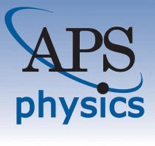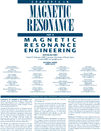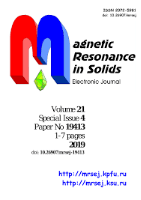
Journal of Magnetics
metrics 2024
Bridging Theory and Application in Magnetics
Introduction
Journal of Magnetics, published by the Korean Magnetics Society, is an essential resource dedicated to advancing the knowledge and understanding of magnetics across the disciplines of Condensed Matter Physics, Electrical and Electronic Engineering, and Electronic, Optical and Magnetic Materials. With a focus on innovative research and development from 2008 to 2024, this journal serves as a platform for sharing cutting-edge findings and theoretical advancements in the field. Although it currently holds a Q4 ranking in established categories, it is an emerging publication that invites researchers, professionals, and students alike to contribute to and engage with its scientific discourse. Notably, it embraces a community of scholars aiming to bridge the gap between theory and practical applications in magnetics, despite its current Scopus rankings reflecting deeper industry competition. Based in South Korea, the journal operates from its office at Korea Sciences & Technology Center, RM 905, Yeoksam-dong 635-4, Kangnam-ku, Seoul 135-703, South Korea. While it does not provide open access, its commitment to academic rigor promises to elevate its stature in subsequent years, making it a vital publication for those keen on exploring the frontiers of magnetics.
Metrics 2024
 0.18
0.18 0.60
0.60 0.50
0.50 20
20Metrics History
Rank 2024
Scopus
IF (Web Of Science)
JCI (Web Of Science)
Quartile History
Similar Journals

PHYSICAL REVIEW B
Pioneering Research in Condensed Matter DynamicsPHYSICAL REVIEW B, published by the American Physical Society, is a leading journal in the field of condensed matter physics and materials science, particularly focusing on electronic, optical, and magnetic materials. With an ISSN of 2469-9950 and an E-ISSN of 2469-9969, this periodical has garnered a prestigious reputation, achieving a Q1 ranking in both relevant categories as of 2023. The journal has recorded significant impact as reflected in its Scopus ranks, notably positioned at #95 out of 434 in Condensed Matter Physics and #75 out of 284 in the Materials Science sector, illustrating its importance in advancing research and discussions in these critical areas. Although it does not offer open access, PHYSICAL REVIEW B remains an invaluable resource for academics, researchers, and professionals seeking to increase their understanding of contemporary issues in condensed matter and material sciences. Established in 2005, this journal continues to foster innovation and dissemination of knowledge, making it a cornerstone publication for those engaged in cutting-edge research.

IEEE Magnetics Letters
Exploring the Frontiers of Magnetics InnovationIEEE Magnetics Letters, published by IEEE-INST ELECTRICAL ELECTRONICS ENGINEERS INC, is a leading journal focusing on the rapidly evolving field of magnetics, encompassing electronics, optics, and magnetic materials. With an ISSN of 1949-307X and an E-ISSN of 1949-3088, this journal serves as a premier platform for researchers to disseminate innovative findings, discussions, and reviews from 2010 to 2024. Recognized for its contribution to the field, it is classified in the third quartile (Q3) of Electronic, Optical and Magnetic Materials, and it holds a respectable place in Scopus rankings, positioned #189/284 in its category. Although it operates under traditional access options, the journal remains vital for professionals and academics seeking to deepen their understanding of magnetics and its applications in modern technology. With its commitment to advancing knowledge and fostering innovation, IEEE Magnetics Letters continues to be an invaluable resource for those engaged in cutting-edge research.

Magnetochemistry
Connecting Scholars through Magnetic DiscoveriesMagnetochemistry is a premier academic journal dedicated to the study of magnetic phenomena in chemistry, published by MDPI, a globally recognized publisher known for its dedication to open science. Since its inception in 2015, this Open Access journal has provided a platform for researchers to share their findings and innovations in the fields of chemistry, particularly in the areas of electronic, optical, and magnetic materials. With a commendable impact factor and competitive ranking, including Q2 in miscellaneous chemistry and materials chemistry, and achieving notable placements within the Scopus ranks, Magnetochemistry stands out as a vital resource for professionals and students alike. By facilitating access to groundbreaking research, it significantly contributes to the advancement of the field, encouraging collaboration and further exploration among its diverse readership. Located in Switzerland, Magnetochemistry offers not only accessibility through its open access model but also a commitment to high-quality and impactful research outputs.

CONCEPTS IN MAGNETIC RESONANCE PART B-MAGNETIC RESONANCE ENGINEERING
Innovating the Future of Imaging and Radiology.CONCEPTS IN MAGNETIC RESONANCE PART B-MAGNETIC RESONANCE ENGINEERING is a premier journal published by WILEY-HINDAWI, dedicated to advancing the field of magnetic resonance engineering. With an ISSN of 1552-5031 and E-ISSN 1552-504X, this journal offers an Open Access platform since 2022, ensuring that research is freely accessible to scholars worldwide. Covering a broad spectrum of applications in medicine, radiology, nuclear medicine, and imaging, it serves as a key resource for professionals looking to stay updated with the latest advancements and innovations in the field. The journal enjoys notable rankings in various categories, including a rank of #137 in Medicine and #26 in Health Professions within Scopus, reflecting its importance and influence in both academic and clinical settings. As a vital conduit for cutting-edge research, CONCEPTS IN MAGNETIC RESONANCE PART B is committed to fostering the growth of knowledge while addressing the critical challenges and technological enhancements within magnetic resonance methodologies. Researchers, professionals, and students can expect to find comprehensive articles that adhere to high scientific standards, promoting discourse and collaboration across disciplines.

APPLIED MAGNETIC RESONANCE
Catalyzing Discoveries in Atomic and Molecular PhysicsApplied Magnetic Resonance, published by Springer Wien, stands as a pivotal academic journal within the realm of Atomic and Molecular Physics and Optics. Established in 1990, this journal has become a prominent platform for disseminating high-quality research papers that explore innovative applications of magnetic resonance technologies. With its ISSN 0937-9347 and E-ISSN 1613-7507, the journal is recognized for fostering a deeper understanding of the theoretical and practical aspects of magnetic resonance across various scientific fields. Despite its Q3 ranking in the 2023 Scopus category, it continues to attract a diverse readership interested in advancing the frontiers of physics. Researchers and professionals are encouraged to contribute their findings, as the journal not only enriches academic discussion but also influences real-world applications, making it an essential resource for burgeoning scientists and seasoned experts alike. Additionally, while the journal is not open access, its comprehensive articles can significantly enhance scholarly knowledge and inspire further research in this vital discipline.

Condensed Matter
Fostering Collaboration in Condensed Matter ResearchCondensed Matter is a leading open-access journal dedicated to the diverse and dynamic field of condensed matter physics, published by MDPI since 2016. With its base in Switzerland, the journal aims to present a platform for researchers and professionals to share innovative findings and advancements in areas such as electronic, optical, and magnetic materials. As of 2023, it is ranked in the Q3 category for both condensed matter physics and electronic, optical, and magnetic materials, a testament to its relevance and growth within the scientific community. Researchers will find valuable insights through its accessible format, fostering collaboration and knowledge dissemination within this interdisciplinary field. With a commitment to enhancing the global dialogue in condensed matter studies, Condensed Matter invites contributions that explore theoretical and experimental approaches, thus pushing the boundaries of understanding in this crucial area of science.

Journal of Advanced Dielectrics
Connecting Scholars Through Cutting-Edge Dielectric StudiesThe Journal of Advanced Dielectrics, published by World Scientific Publishing Co Pte Ltd, is a pivotal open-access platform since 2014 dedicated to advancing research in the fields of dielectrics, ceramics, and composites. Based in Singapore, this journal aims to bridge the gap between theoretical developments and practical applications in Electrical and Electronic Engineering, Condensed Matter Physics, and Electronic, Optical, and Magnetic Materials. With an impressive classification in the 2023 Quartile Rankings indicating its significance within its categories, and notable Scopus Rankings that highlight its impact and relevance, this journal serves as a vital resource for scholars and professionals committed to cutting-edge research and innovation. As it continues to flourish through the converging years from 2015 to 2024, the Journal of Advanced Dielectrics stands as an essential conduit for the dissemination of knowledge in advanced material sciences, making it an indispensable asset for today's research community.

Magnetic Resonance in Solids
Exploring the Frontiers of Atomic and Molecular PhysicsMagnetic Resonance in Solids is a pioneering open-access journal, published by Kazan Federal University in the Russian Federation since 2006. With an ISSN of 2072-5981, this journal focuses on a diverse array of disciplines within Atomic and Molecular Physics, Electronic, Optical and Magnetic Materials, Nuclear and High Energy Physics, and Spectroscopy. Although its impact factor currently places it in the fourth quartile across multiple categories, the journal provides invaluable insights into the evolving field of magnetic resonance, informing researchers and professionals alike. It features a wide range of original research articles, review papers, and technical notes that foster the exchange of knowledge in solid materials characterization through magnetic resonance techniques. Despite facing competitive rankings, its open-access nature ensures broad dissemination of critical findings, appealing to a global audience of scientists, academics, and students seeking to advance their understanding of solid-state phenomena. The journal is continuously committed to promoting high-quality research and fostering innovation in its areas of study.

Lithuanian Journal of Physics
Connecting Scholars through Groundbreaking ResearchWelcome to the Lithuanian Journal of Physics, an esteemed publication helmed by the Lithuanian Physical Society, dedicated to advancing the field of physics and astronomy. Established in 2008 and continually publishing insightful research through 2024, this journal aims to provide a platform for high-quality scholarly articles that contribute to the understanding of various physical phenomena. With a steady presence in the academic landscape, the journal is currently ranked in the fourth quartile of the Physics and Astronomy category and is positioned at the 18th percentile in its Scopus ranking, reflecting its niche focus and accessibility for researchers and students alike. Although currently not operating under an open access model, the journal remains a vital resource for professionals seeking to stay informed on the latest developments in the field. The Lithuanian Journal of Physics invites contributions that inspire collaboration and innovation in physical sciences, making it an invaluable resource for the global scientific community seeking to expand knowledge within this dynamic field.

SEMICONDUCTORS
Fostering breakthroughs in semiconductor technology.SEMICONDUCTORS, published by PLEIADES PUBLISHING INC, is a prominent journal that provides a platform for researchers and professionals in the fields of Atomic and Molecular Physics, Condensed Matter Physics, and Electronic, Optical and Magnetic Materials. With an ISSN of 1063-7826 and an E-ISSN of 1090-6479, the journal has been diligently disseminating knowledge since its inception in 1996 and continues to pave the way for innovative research until 2024. Although currently unclassified in the Open Access model, its influence is underscored by its rankings in Scopus, where it ranks in the 21st-22nd percentile across critical scientific categories. SEMICONDUCTORS serves as an essential resource for cutting-edge research, fostering a greater understanding of semiconductor materials and their applications, thereby assisting the scientific community in pushing the boundaries of technology and innovation.